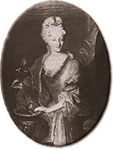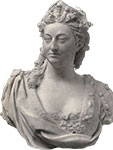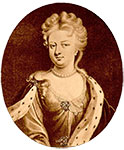Caroline of Ansbach (1683-1737)Princess of Wales (from 1714) | |||
 |
 |
Wilhelmine Caroline of Brandenburg - Ansbach was a daughter of Johann Friedrich, margrave of Brandenburg - Ansbach (d. 1686). She was born at Ansbach on 1 March 1683 and spent her youth primarily at Dresden and Berlin, where she formed a close friendship with Sophie Charlotte (1668-1705), queen of Prussia (from 1701-1705) and wife of Friedrich I. (1657-1713). In the autumn of 1704, the twenty-one-year-old Princess Caroline of Ansbach met Gottfried Wilhelm Leibniz, who was visiting Sophie Charlotte and her mother Sophie (1630-1714), the electress of Hanover, at Sophie Charlotte's palace at Lützenburg (later, Charlottenburg) outside Berlin. Leibniz, who already enjoyed a close friendship with Sophie Charlotte and the Electress Sophie, became thereafter Caroline's good friend and tutor, and they corresponded until the end of Leibniz's life in 1716.
In September 1705, Princess Caroline married the electress Sophie's grandson, Georg August (1683-1760), who was then the electoral prince of Hanover, and she spent the early years of her marriage in Hanover. But in 1701 the English Parliament approved the Act of Settlement, in which the electress-dowager Sophie was proclaimed the next in line to the British throne. But Sophie died on 8 June 1714, so following the death of queen Anne on 12 August 1714, her eldest son, Georg Ludwig (1660-1727) moved to London, along with his only son, Georg August, to become the first Hanoverian to ascend the British throne. On 12 October 1714, Caroline, the new Princess of Wales, followed her husband and her father-in-law to London. When they transplanted to London, Caroline and Georg August left their then seven-year-old eldest son, Friedrich Ludwig (1707-1751), behind in Hanover. He did not rejoin them until 1727, shortly after Georg August had ascended the throne.
At the time of Georg Ludwig's accession to throne of England, Leibniz was Librarian and Privy Counselor of Justice to the court at Hanover, where he had served for nearly forty years—first under Georg Ludwig's uncle, Johann Friedrich (1625-1679), and then under Georg Ludwig's father, Ernst August (1629-1698), who became the first elector of Hanover in 1692. Georg I. Ludwig, who had never fully appreciated the extent of his Privy Counselor's genius and fame, and had always been rather ill-disposed towards him, refused to summon Leibniz to join the royal family in London, ostensibly on the grounds that Leibniz had not made progress — sufficient, at least, to satisfy the king—on writing the history of the king's royal House of Brunswick with which he had been commissioned many years before. In December 1714 Leibniz petitioned the king, through Caroline and the king's Hanoverian Prime Minister, to make him historiographer of England on the grounds that his history of the House of Brunswick required him to take account of the history of England. The king refused, but Caroline continued to champion Leibniz's cause. In September 1715 she told Leibniz that she had again spoken to the king about his desire to become historiographer of England, but the king replied: "Er muss mir erst weisen daß er historien schreiben kann; ich höre er ist fleißig [He must first show me that he can write history; I hear that he is diligent]" (Klopp, p. 46).
Prior to this time, at the beginning of 1713, the Royal Society in London had issued a report, the Commercium epistolicum, rendering a decision on the priority dispute between Newton and Leibniz concerning the invention of the calculus—a dispute that had been simmering for some years.1 The report, authored by Newton himself, unjustly condemned Leibniz for plagiarism. But the dispute between Leibniz and Newton had already widened to embrace other matters, in particular, Newton's notion of gravity. In § 19 of the Preliminary Dissertation that prefaced the Theodicy (1710), Leibniz complained that Newton's gravity represented a reintroduction of the outmoded idea of action at a distance; and in a letter of 10 February 1711 to the Dutch physicist Nicolaas, Hartsoeker, which was published in the Journal de Trévoux of March 1712 and later reprinted in the London periodical Memoirs of Literature (5 May 1712) and in the Amsterdam edition of the Journal des sçavans (December 1712), Leibniz declared that Newton's gravity "is a senseless occult quality, which is so very occult that it can never be cleared up, even though a Spirit, not to say God himself, were endeavoring to explain it" (G.III.519).
Leibniz first informed Princess Caroline of the dispute with Newton in a letter of 10 May 1715, telling her of the opinion of a French journalist who had suggested that the dispute was between Germany and England rather than simply between Leibniz and Newton. Consequently, Leibniz explained that king Georg I. should appoint him historiographer of England to demonstrate that Leibniz was esteemed as much as Newton, who was then Minister of the Mint, and thus to restore the honor of Hanover and Germany. [Klopp, pp. 37-38]
In a letter of 14 November 1715 (N.S.), Caroline told Leibniz that she wanted to have his Theodicy translated into English and that for this her friend the bishop of Lincoln had recommended Samuel Clarke (1675-1729), a chaplain to the king whom Caroline described as "a close friend of chevalier Newton" (Klopp, p. 50). Still stinging from the nasty priority dispute with Newton and his followers over the invention of the calculus, stinging, too, at having been left behind in Hanover when the royal family moved to London, Leibniz—now seeing his friend and protégé, princess Caroline, fallen into the midst of his dire intellectual enemies, the Newtonians—could apparently contain himself no longer; when he responded to Caroline he included a short, but transparently bitter, outline of his complaints against the English philosophers. "Natural religion itself," he began, "seems to decay [in England] very much" (Klopp, p. 54]. He went on to suggest that Locke and his followers were uncertain whether the soul may be material and hence naturally perishable. Against Newton he laid that charge that, since he maintained that space is the "sensorium" of God, he implied that the objects of sense were not entirely dependent on God and so could not have been created by him. He further charged that Newton and his followers held that God was required to intervene in the natural world on occasion in order to maintain and mend the universe, "as a clockmaker mends his work" (Klopp, p. 55). He ended by noting that on his own view, "when God works miracles, he does not do it in order to supply the wants of nature, but those of grace" and that "whoever thinks otherwise, must needs have a very mean notion of the wisdom and power of God" (ibid.).
Caroline showed Clarke what Leibniz had written and asked him to reply. In her letter to Leibniz of 26 November 1715, Caroline enclosed Clarke's first reply and reported that "we are thinking seriously of getting your Theodicy translated; but we are still looking for a good translator" (Klopp, p. 52). She added that "Dr. Clarke is too opposed to your opinions to do it; he would certainly be the most suitable person of all; but he is too much of Sir Isaac Newton's opinion and I am myself engaged in a dispute with him" (ibid.). Having already sent Leibniz copies of Clarke's books, Caroline wrote: "I implore your help; he gilds the pill and is not willing to admit that Mr. Newton has the opinions which you ascribe to him." Caroline also reported that "neither Dr. Clarke nor Mr. Newton wishes to be thought a follower of Mr. Locke" (Klopp, pp. 52-53). She then added a line that must have warmed Leibniz's heart: "but I cannot and would not wish to be one of theirs [Klopp, p. 53]." Leibniz sent his second paper to Caroline around the first of the year, 1716, saying "I hope your Royal Highness will have copies kept of what is given to her and of what I send, the better to be able to judge it" (Klopp, p. 60).
Thus was begun what is perhaps the most famous and influential of all philosophical correspondences, a correspondence that ranged over a vast and rugged terrain of metaphysics, physics, and theology, and a correspondence in which Newton himself seems to have played some role, since in her letter to Leibniz of 10 January 1716, in which she enclosed Clarke's second letter, Caroline wrote that Clarke's answers were "not written without the advice of the chevalier Newton" (Klopp, p. 71). For her own part, Caroline told Leibniz that she "should like [Newton] to be reconciled with you. . . . [I]t would be a great pity if two such great men as you and he were to be estranged by misunderstandings" (Klopp, pp. 71-72). She repeated her appeal for reconciliation in her letter to Leibniz of 26 June, in which she enclosed Clarke's fourth letter. With the kind of detachment from the struggles for worldly recognition that perhaps come more easily to those born to royal privilege, Caroline could actually ask, without hint of irony: "What does it matter whether you or the chevalier Newton discovered the calculus?" She added that "you are the great men of our century, and both of you serve a king who merits you" (Klopp, p. 115). In his response of 31 July, Leibniz was understandably defensive:
"I do not want to put off mentioning to Your Royal Highness how moved I am by her continued good graces. I hope that she will not deem it wrong that I vindicate myself of the recent appearances of animosity and passion against M. Newton. If Your Royal Highness knew with what incivility his followers have attacked me, of which he was not unaware, she would have praised my moderation. I have not deigned to respond to any such persons who observe none of it themselves. But when Mr. Newton has determined to appear himself, I have responded to him, as is proper, and I hope that my response will have satisfied those who have chosen to examine it, not only with respect to the justice of my cause, but also with respect to manners. I could not endure expressions that attacked my good faith, and it was proper to reject them forcefully; but I believe that it will be noted well enough that I have done it without emotion." [Klopp, p. 129]
Caroline's letter of 26 June also recounted this amusing encounter with the astronomer John Flamsteed (1646-1719):
"I have been this past week to Greenwich at the home of Flamsteed [sic] who received me in his observatory, where instead of the stars I had the most beautiful view of the world. He asked me for news of you, and he told me in an even voice that you were an honorable man, but that Sir Isaac Newton was a great rogue [un grand fripon], because he had stolen two stars from him. I was unable to keep from laughing. His house and his figure have the air of Merlin." [Klopp, p. 115]
The correspondence between Leibniz and Clarke was ultimately to comprise five letters from Leibniz (in French) and five replies from Clarke (in English). Clarke's fifth reply was dispatched on 29 October 1716. To this Leibniz was unable to respond, for he died little more than two weeks later, on 14 November 1716. But as Leibniz had requested, Caroline carefully preserved all the letters, and the correspondence was subsequently published by Clarke in 1717, dedicated to "her royal highness the Princess of Wales."
Caroline took the side of her husband in his ongoing dispute with his father, George I. Ludwig (1660-1727). Matters came to a head in 1717. The Prince and Princess of Wales were driven from the court by George I. Ludwig and ostracized. They were even deprived custody of their children and were forced to take up residence in London at Leicester House, and in the country at Richmond. The Prince and Princess were formally reconciled with George I. in 1720, and following his death they were crowned king and queen of England in October 1727.
Caroline became one of the most popular queens in the history of the English monarchy. In politics she was a supporter of minister Sir Robert Walpole, whom she helped to stay in power and in charge of church patronage. She exercised great tolerance in her position and appointed bishops known more for learning than for orthodoxy. She also exercised great tolerance in her marriage, flattering her husband's vanity and acknowledging his mistresses. The marriage was a generally happy one, and Caroline bore her husband eight children. She died on 20 November 1737.
![]()
Notes
1For a masterful account of the long controversy between Newton and Leibniz over the discovery of the calculus, see A. Rupert Hall, Philosophers at War (New York: Cambridge University Press, 1980).
Sources
- The Encyclopaedia Britannica, 13th edition. New York: The Encyclopaedia Britannica, Inc., 1926.
- Aiton, E. J. Leibniz: A Biography. Boston: Adam Hilger, 1985.
- Alexander, H. G., ed. The Leibniz-Clarke Correspondence. New York: Barnes & Noble, 1956.
- Gerhardt, C. I., ed. Die Philosophischen Schriften von Leibniz, 7 vols. Berlin: Weidmann, 1875-90; reprinted Hildesheim Olms, 1971. (Abbreviated as "G")
- Klopp, Onno, ed. Correspondenz von Leibniz mit Caroline. New York: G. Olms, 1973.
Web






